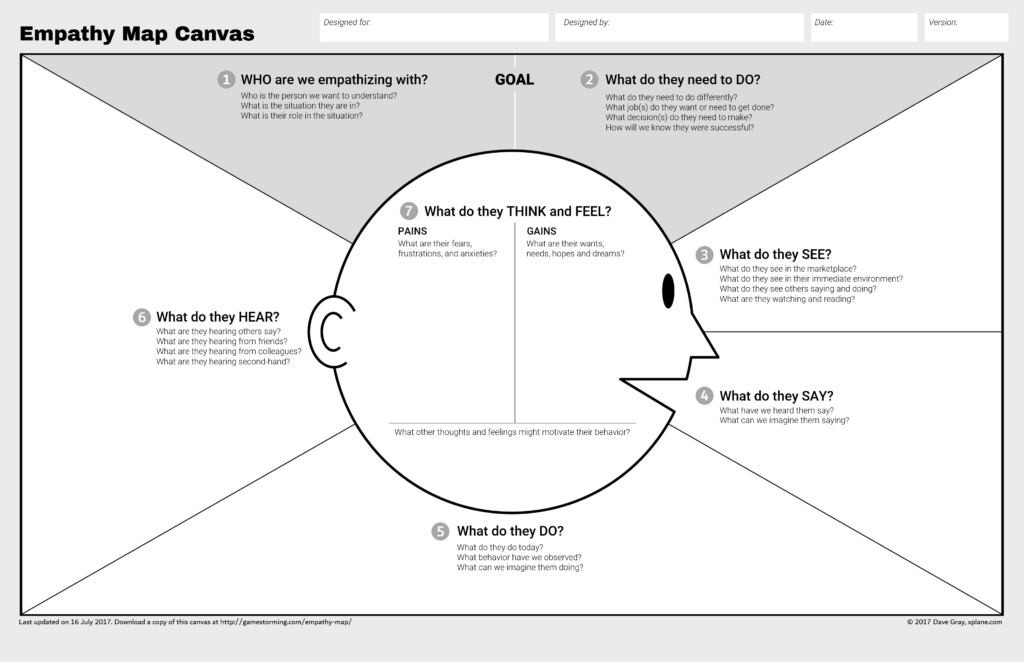The way your business engages with the people that fall under their different customer personas will prove the mapping process’s effectiveness.
In business today, there is a massive emphasis on building robust relationships with customers. And all the elements of a customer’s relationship with a brand has to hinge on exceptional customer experiences (CX). Amazing customer experiences can create immense value for both the brand and the customer, far beyond any other strategy.
Empathy mapping (or customer experience mapping) comes in here as a critical tool for ensuring your teams focus entirely on the customer in the way they carry out their responsibilities. This customer-centric approach helps businesses to uncover all the parts of their customers’ situation in the right context.
Leveraging a customer empathy map will lead to designing higher-value solutions that have a more profound impact on them.
In today’s ultra-digitized business clime, digital products, and services like your website or mobile app are a cornerstone aspect for cultivating the ideal customer experience.
Every aspect of your digital property’s design and functionality must take a cue from a robust understanding of your target audience. But you have to get to this level of audience knowledge before you can design, deliver, and maintain the perfect customer experience. The only place to start is with a customer experience mapping process.
 Empathy understands someone else’s situation the way they see it.
Empathy understands someone else’s situation the way they see it.
Empathy is a potent attribute of a customer experience design. Without empathy, you won’t be able to put yourself in the shoes of your target audience. You won’t be able to see what they see, feel what they feel, and process their experiences the same way that they do.
When you make empathy central in this regard, many benefits come with it. For one, it deepens your understanding of your audience. This comprehension eliminates any form of guesswork, not just in the solution you’re creating for them, but also in how you create that solution.
Because empathy understands customers and their needs at the deepest possible level, it also fosters the realization that your business products or service are often not a one-size-fits-all solution. The solution is nuanced, usually on an individual basis.
It doesn’t matter if you run or plan to establish an e-commerce store on Amazon’s scale or a simple custom writing review platform like Online Writers Rating or Best Writers Online. Leveraging empathy in customer comprehension, solution design, and maintenance is a no-brainer.
Remember, though, that leveraging empathy will require you to hold back on forming assumptions and biases and actively engage your ideal audience.
 The Empathy Map Canvas.
The Empathy Map Canvas.
The traditional format of the empathy map contains four quadrants that help to glean and categorize critical customer information.
But the version created by Dave Gray and canvas design extraordinaire, Alex Osterwalder, is probably the best empathy map canvas available today. It goes into much richer detail about the customer’s context, experience, influences, and needs.
This particular version of the empathy map has seven quadrants, each contributing to a holistic design of a target audience persona. These quadrants seek to attain the following information:
Quadrant 1. Seeks to accurately identify the ideal customer by discovering their particular situation and their role in said situation.
Quadrant 2. This quadrant is dedicated to what the customer needs to do differently to arrest their situation. This question is answered in terms of the jobs they need to get done, the decisions they need to make, and how to measure their success.
Quadrant 3. This quadrant focuses on how the customer sees their immediate environment and the marketplace in general. It also includes looking into what influenced them: what they are watching, reading, and the words and actions of people who have their attention.
Quadrant 4. Owing to the previous quadrant, this one focused on what the customer says and what they could say.
Quadrant 5. Here, the mapping process is concerned about what the customer is currently doing, their discernible behavior pattern, and, consequently, what they could do.
Quadrant 6. This one bears a slight resemblance to the third quadrant. It seeks to identify what the customer hears from others, especially those in their immediate circle, like friends, family, and colleagues. It also seeks to distinguish which of these information is first hand and which are second-hand information.
Quadrant 7. This, the last quadrant, pits the customer’s pains against his gains. It seeks to discover his fears, frustrations, and anxieties, but also his wants, needs, hopes, and dreams.
This canvas is critical to the way your empathy mapping will look. It gives essential texture to the building of your audience persona, and you interpret their user journey from beginning to the end.
 Tips On How To Create An Empathy Map That Elevates Your Customer Experience.
Tips On How To Create An Empathy Map That Elevates Your Customer Experience.
Look beyond just your ideal customer.
During your audience persona development, it helps to look beyond your ideal audience. For every customer group outside your ideal audience, there is greater nuance and depth to be learned.
Different audiences in your target market may need the same solution in various ways due to their different situations and context. As a result, they’ll respond in different ways to your empathy.
You’ll need all this information to design broader and deeper-reaching customer experiences, products, and services.
Use real user data and research to glean new insights.
You can gather user data in several ways: user interviews, quality-focused surveys, observational studies. The impact of empathy mapping, especially at the onset of a new project, is invaluable.
It gives direction to design strategy, requirements of product and services and shines the light on the best ways to deliver value to your audience. There is also the added benefit of helping you readjust your current products and services and uncover new opportunities and challenges.
The experience mapping process is also an effective way to conduct a gap analysis to measure what you know about your audience against what you don’t know.
Develop a 360° view of your customer persona with collaboration across teams.
The empathy mapping process helps you to create the ideal product/service and customer experience. But there are possibly other teams within our organization responsible for selling the product, delivering it, and handling support needs.
These teams need to be on board and up to speed as well in comprehending the consumer personas you’ve developed. The way the members of these different teams perceive the consumer personas should also be represented visually on the Empathy Map Canvas.
It gives you an all-around view of each persona. This way, team members will be able to make the right inquiries and uncover patterns that will help in categorizing similar persona attributes.
In conclusion, getting these different teams to collaborate boosts the entire mapping process and its results.

Final Words
Remember that empathy mapping is the end goal of the mapping process. The way your business engages with the people that fall under their different customer personas will prove the mapping process’s effectiveness.










